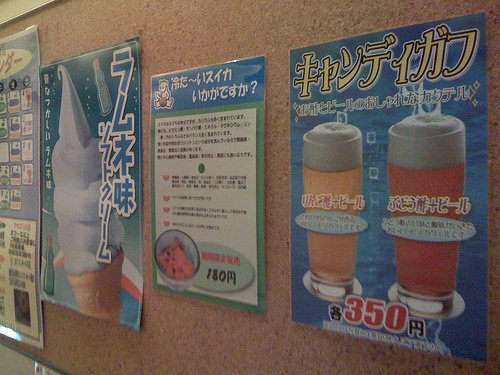There are naturally many large and small forms of culture shock a person experiences when they go go live in a foreign country, and I’ve had my share in Japan. One was getting used to the new tastes that were waiting for me. Right off the bat, Japanese milk tastes…different when you’re used to American milk, at least at first. It’s not bad or anything, but something about the Japanese cows or how the milk is processed took me time to get used to. Some other familiar products, such as Oreos, also taste slightly different (not as much sugar in them), although humans can adapt to anything. Then there were familiar products that came in “odd” taste variations, like milk flavored bread, salt flavored ramen (which is really chicken flavored), or — it’s really delicious, trust me — “coffee jelly,” coffee-flavored gelatin, excellent on a hot summer’s day. Unlike America, where companies tend to think in terms of their next big national product roll-out, Japanese companies are more comfortable releasing short-run products on a more limited scale, which sometimes leads to some really interesting taste experiments, like Cucumber Ice Pepsi. Readers of J-List’s snack pages know that you can always find something interesting in the taste department, from sukiyaki-flavored furikake to sprinkle on rice to rose-flavored gum and candy to the delicious Green Tea Butterscotch from Chealsea, we’ve got lots of fun stuff for you to try.

I noticed that the world’s oldest woman passed away at the tender age of 114 the other day, and I wasn’t surprised at all to see that she was Japanese. Mrs. Yone Minagawa was born in Fukushima Prefecture in 1893 when Grover Cleveland was in office, and was already in her 50s at the end of World War II — wow. Thanks to healthy diets, social networks of lifelong friends and a generally competent national medical system, Japanese females are the longest lived people on the planet, with an average life expectancy of 85.8 years. Although it probably didn’t get much mention in Michael Moore’s “SICKO” documentary — I’ve long stopped expecting the government and media in America to look at the various systems at work in Japan — I think the country’s medical system could be studied as a model that obviously works (since people are living a long time). It can best be described as a “blend” of private hospitals, clinics and related companies and a publically-guided insurance system, which imposes a framework that companies must work within. When you go to the doctor or dentist you bring your insurance card, and in general 70% of the costs will be covered. There are trade-offs, of course. Because of the cost caps instituted by the two health insurance systems — Social Insurance for employees of medium-to-large companies, and Citizen’s Insurance for everyone else — not all types of care are available, so if you want to get the really good ceramic caps on your teeth as opposed to the ugly silver ones, you may need to pay for that yourself. Also, expect to go to the dentist 8 times to fix those two fillings, since they’re not allowed to charge you more than a certain amount per day. Since there are more limitations on the Japanese medical system, some companies don’t see the same amount of profit as in the U.S., and as a result, there’s less investment in technology here (although I’ve never known of a hospital that needed an MRI scanner and didn’t have one).
I receive a lot of questions from people interested in living in Japan someday, so I thought I’d address some of these issues in case it’s helpful to anyone. While it certainly is difficult to come to a country as different from the U.S. or Europe as Japan is, it’s certainly doable if you are determined. Many foreigners come to Japan on a tourist visa (3 months) and use that time to look for a job. When you find one, you have to leave the country once to process your working visa then re-enter on that visa — most gaijin travel to nearby South Korea and do some sightseeing while they wait for their paperwork to come through. Alternately, citizens of some lucky nations like Canada, Australia and New Zealand can come on “working holiday” visas instead. Westerners are usually shocked by the difficult system of “key money” you must pay when renting an apartment. Between a security deposit (2 months), a finders-fee (paid to the company that got the apartment for you), first months’ rent and “thank you money” (a move-in bonus for your landlord), it can cost $2000-4000 just to move into a small apartment. Of course, any discussion of how to work in Japan is precluded by the fact that to get a working visa at all, you must have a degree from a four-year university. So whenever young people interested in Japan ask me how they can come work in Japan, I invariably advise them to find a good, well-rounded university and get a degree — do that, and you’ll be surprised how easily the rest can fall into place.















